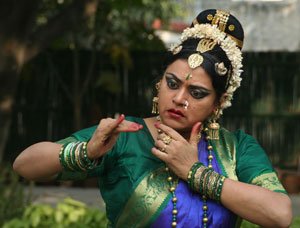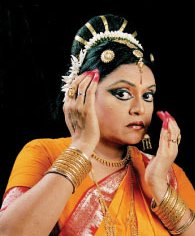
|
 |

|
 |
Swapnasundari: Classicism of Vilasini Natyam is evident - Lalitha Venkat December 3, 2008  With her talents honed by veteran dance gurus, Swapnasundari has been a dominant presence in Kuchipudi and Bharatanatyam through the '80s and '90s. She learnt the art of the Telugu devadasis from several temple dancers, including the late Maddula Laxminarayana. She revitalised this ancient dance with the guidance of the late historian and poet, Dr. Arudra, who termed it Vilasini Natyam. She realigned it with rituals of worship in 1996. Swapnasundari is the first and only present-day performer to dance annually in the rituals of worship inside a temple. In 2003 she was awarded the Padma Bhushan for her contribution to dance, particularly the Andhra dance forms, becoming the youngest classical dancer of her genre to receive such an honour. Swapnasundari is called the "The queen of Kuchipudi dance" and teaches at her institution Kuchipudi Dance Centre in Delhi. She is also an accomplished singer. Her CDs and cassettes of songs for Kuchipudi are very popular. After many years of dancing Bharatanatyam, why did you suddenly stop performing it? Various reasons. The most important one being my desire to focus extensively on the unique features of the Bharatham of yore that flourished in the hands of Telugu Temple-dancers and Court dancers. Its study, analysis, and effective reclamation required much more time and attention than I was able to give with my hectic performance schedules in Bharatanatyam. What was your inspiration to revive the temple dance form of the devadasis of Andhra? An abiding interest in Andhra's cultural, social and political history and my deep commitment to the task of bringing another rich cultural expression of the Telugu people before the art-loving public. Spurred on by the inspiration derived, first by watching some of the last living great artists from this tradition and then learning directly from them. How different is Vilasini Natyam from Kuchipudi?  There is no direct relationship between the two. Any fleeting resemblance between them is somewhat like the passing similarity between Mohiniattam / Nangyar Koothu and Kathakali. The Telugu hereditary dancers of Vilasini Natyam from whom I have learnt, have never studied from Koochipoodi masters and most of them had not seen Koochipoodi performances until Television entered their lives. In fact, almost all of them were unfamiliar with the name of the late Bala Saraswati too! Vilasini Natyam consists of over 100 Nrittha units (basic adavus and their permutations and combinations) in the Northern and coastal school alone. Another 35 to 40 Nrittha units are of the Southern school. None of these adavus find place in the old sampradaayam of Koochipoodi as taught to me by its traditional Gurus. The approach and methodology of Abhinaya in Vilasini Natyam differs from what is currently followed in Koochipoodi. The scope of Abhinaya and its traditional repertoire as practiced by the Telugu Saani artists, who have provided the material for Vilasini Natyam, is staggeringly vast. In which dance form is today's generation more interested in training - Vilasini Natyam or Kuchipudi? Koochipoodi has many learners as it joined the mainstream more than forty years ago. Over the past ten years, a lot of interest has been generated towards Vilasini Natyam all over the country. Its students will inevitably grow in numbers over a period of time. How do you differentiate between the theatrical, court and ritual traditions of Vilasini Natyam? I am attaching a separate detailed note as this has been elaborated many times by me in various forums. (Article) There are a coastal area tradition, and a southern Andhra tradition? What are the major differences? Very generally speaking, the Northern and North coastal traditions employ softer and more rounded dance movements whereas the Southern tradition employs more linear movements. However, all schools of Vilasini Natyam eschew stiff body-postures and rigid movements. You use video projection in your performance. You don't think it's damaging to the art form by introducing such modern aspects? Video projections are never used as a part of our traditional Margam performances. If and when any audio-visual projection is used, it is only in-between our traditional items, to serve as an effective introduction as a lot of historical information is required to be packed into our announcements. As for the use of multi-media in our ballet-productions and experimental work, I say - Why not? When martial artists, rope-climbers or fire-jumpers are freely employed in many experimental works, why not multi-media? Who draws the line in experimental work? Do you think Vilasini Natyam will get recognition as a classical dance form of India? Who recognizes? Vilasini Natyam is an age-old dance tradition of the Telugu hereditary dancing community comprising female dancer-singers dedicated to temple-service and court-service. Its "classicism" is evident in the dance itself. This form has survived for over 1000 years on its intrinsic artistic strength. It will continue to do so through the present dedicated efforts to sustain and further it. These are already bearing fruit. Starting with my own performances in the nineties and now additionally through the dancers I have trained, Vilasini Natyam continues to be featured in prestigious dance festivals all over the country. We receive invitations from major organizations for solo performances. My National Program of Dance in Vilasini Natyam style was telecast by National Television way back in the mid nineties. In all these forums, our demand that Vilasini Natyam should be featured in its own right and not as an adjunct to Koochipoodi, has been accepted. Media response has also been very encouraging, to say the least. Above all, the response of the audience has been overwhelming. So, what is left to "recognise?" To the best of my knowledge, there is no formal procedure of "recognition" that is followed by any official cultural body. For instance, as per recent information given by the officials of the Sangeet Natak Akademi, it has not "formally accorded" such a "recognition" to any dance tradition. According to its officials, the Sangeet Natak Akademi is not taking responsibility for the claims made by various dance styles of today that they have been "accorded classical status." Going by all this, the question of "recognition" for Vilasini Natyam appears to be irrelevant. Your point of view on Ramayana in the performing arts, and also with reference to Ramayana Kalpa Vrikshamu of Viswanatha Satyanarayana. One of the most popular subjects, perhaps next only to the Krishna theme. I would be giving detailed comments on 'Soorpanakha' in Ramayana Kalpa-Vrikshamu in my lec-dem and in the article which is being sent to Natya Kala Conference organizers. Your comment on the Chennai season. Over-crowded...Could become counter-productive if the programs are not more spread- out. This can only happen through greater co-ordination between Sabhas. Contact: e-mail: vilasininatyam@yahoo.co.in |